Are you grappling with unexpected glitches and errors on your WordPress site? You're not alone. From the dreaded 'White Screen of Death' to perplexing permalink issues, these common WordPress errors can make even the most experienced website owners feel helpless.
But fear not - these errors, while troublesome, can often be fixed with a few strategic steps. In this comprehensive guide, we'll demystify the 13 most common WordPress errors and provide actionable solutions to get your site back on track. Let's turn those website woes into wins.
Error 1: How Can You Fix The White Screen of Death
When this error surfaces, it's quite the conundrum, isn't it? You're left with no error message, no breadcrumbs to follow, and essentially no hint of what to do or where to go. It's puzzling and certainly puts one in a bit of a spot.

The WordPress White Screen of Death (WSOD) occurs when there's a PHP or database error that halts the execution of the WordPress software.
This can be caused by a variety of factors, such as:
- Plugin Conflicts: This is a common cause of the WSOD. If you install a new plugin or update an existing one, it could potentially cause conflicts with other plugins or your website's theme.
- Theme Issues: If your theme has been corrupted or coded improperly, it can cause the WSOD.
- Exhausted Memory Limit: If your website exceeds the memory limit allocated by your hosting server, it can result in the WSOD.
- Server Errors: Problems with your server, such as being down or having connectivity issues, can also lead to the WSOD.
Solution
While numerous solutions exist for addressing this error, I'm going to focus on the two simplest methods, which I'll detail for you below.
1. Clear the Browser Cache
A browser cache is a place on your computer where the browser keeps things that it downloaded once in case they're needed again. It's like a storage space for temporary internet files. The aim is to speed up how quickly websites load. For example, if you visit a site often, your browser may store images from that site, so it doesn't have to download them every time you visit, making the page load faster.
The downside is that the browser cache can fill up with old, outdated files, potentially causing issues with websites not loading properly, and it can also take up significant disk space.
Here's how to clear the browser cache in some of the most common browsers:
Google Chrome:
- Click the “three dots” in the top-right corner of the browser.

- Go to "Settings".
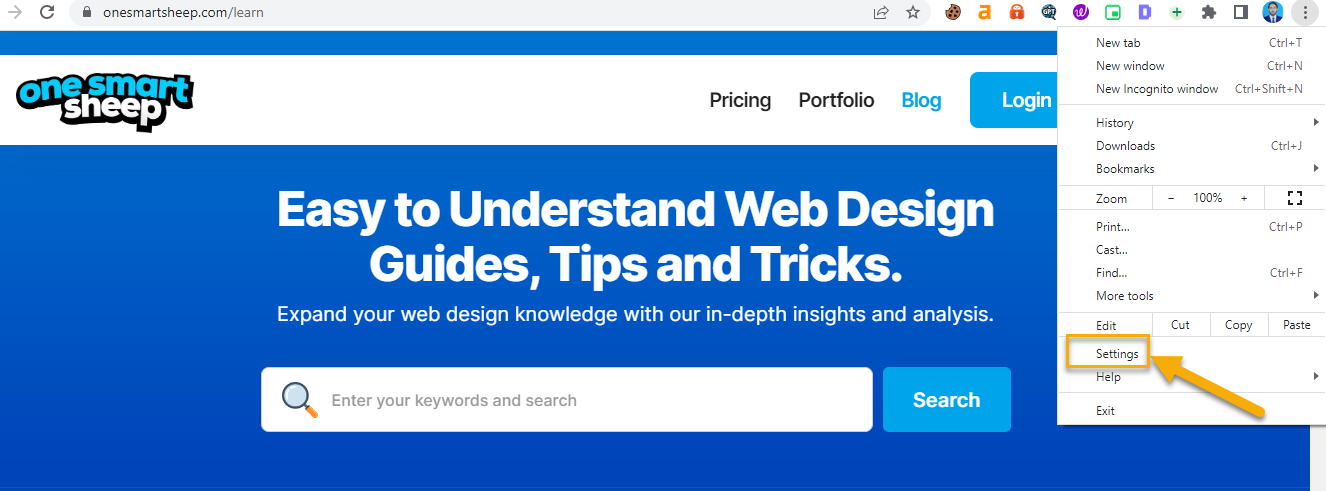
- Now click on the “Privacy and and security”.
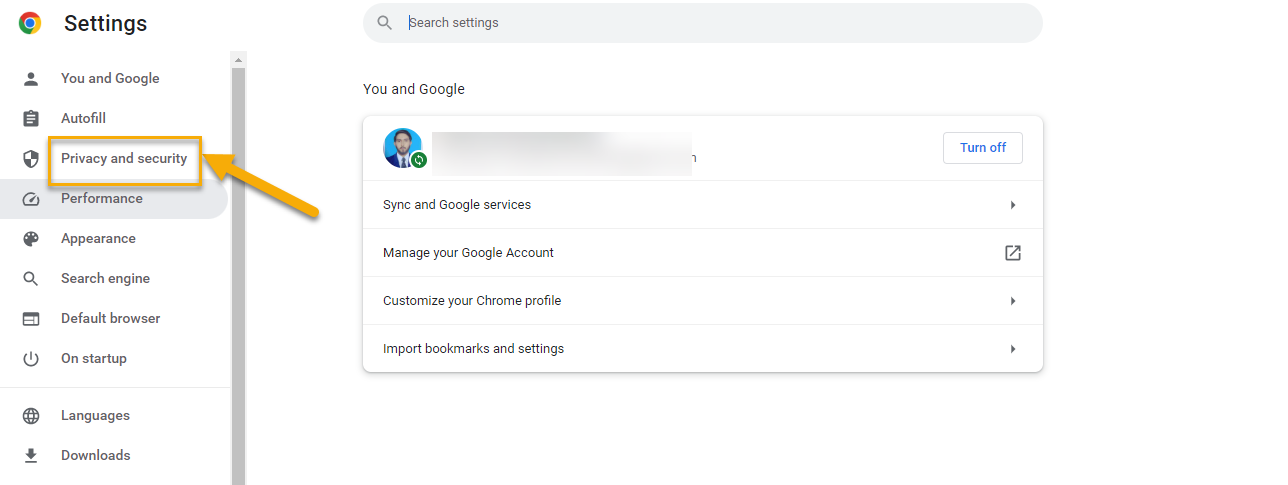
- Now click on “Clear browsing data.”

- Choose a time range. To delete everything, select "All time."
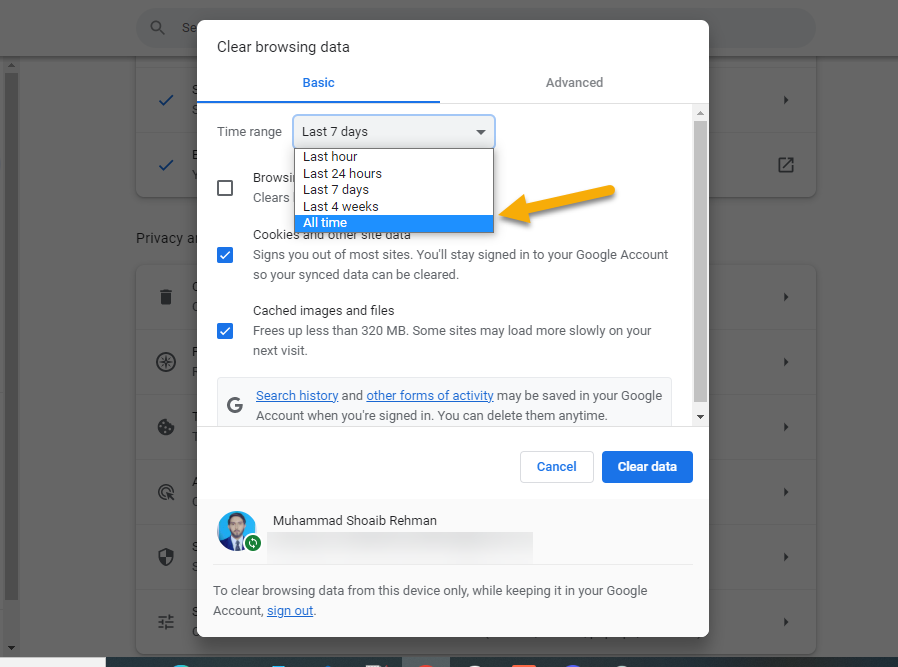
- Check the boxes for "Cookies and other site data" and "Cached images and files."

- Click "Clear data."

2. Enabling Debug Mode
Debug mode in WordPress is an instrumental feature used to unearth crucial data about potential errors that could lead to the dreaded WordPress White Screen of Death.
If emptying your browser cache doesn't do the trick, activating the debug mode should be your next course of action.
To switch on the debug mode, you'll need to venture into the wp-config.php file. This file can be located either by signing in to your CPanel or by establishing an SFTP connection with your server using an FTP client like FileZilla. Once enabled, the debug mode should shed light on what might be causing the issue.
In order to access this wp-config.php file you need to install the “File Manager” plugin. To install this go to “Appearance” and click on “plugins”.
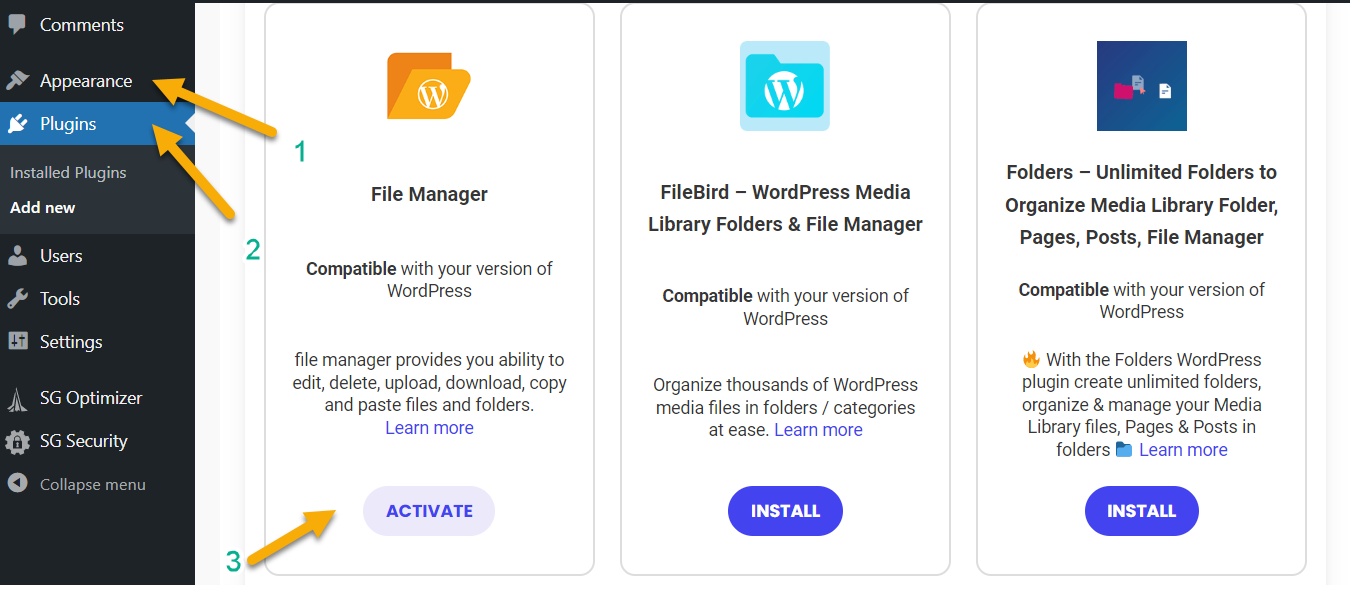
Once you've successfully installed the File Manager plugin, navigate to your dashboard. There, you'll find "WP File Manager." Go ahead and click on it.

Once you select "WP File Manager," you'll see a list of all your files displayed. From this collection, you'll need to locate the specific file you're after: "wp.config.php."

Open this file with any editor and then find ‘WP_ DEBUG’ , is False or true.
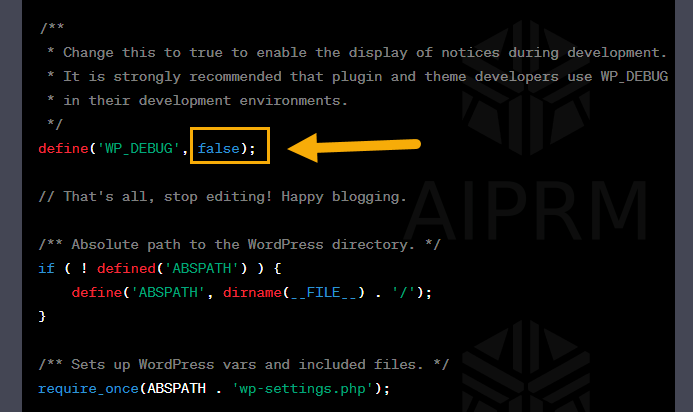
This code should be placed in your WordPress wp-config.php file. The define('WP_DEBUG,' false); line controls whether debug mode is enabled or not. If you change false to true, WordPress will start showing PHP notices, warnings, and errors, which can be useful for development and debugging.
Error 2: How Can You Fix Internal Server Error

The Internal Server Error, often known as a 500 Internal Server Error, is one of the most common and frustrating issues you might encounter on your WordPress site.
This error message is particularly annoying because it's quite vague—it doesn't provide any specific information about what exactly went wrong; hence it's termed a "server-level" error.
The Internal Server Error can occur due to a number of reasons, including:
- Corrupted .htaccess File: This is one of the most frequent causes of the 500 Internal Server Error. The .htaccess file is used to manage and control access to the website's directories. If it's improperly modified or becomes corrupted, it can disrupt the normal functioning of your WordPress site.
- PHP Memory Limit Issues: WordPress, plugins, and themes all require memory to run. If they exhaust the available memory limit, it could lead to an Internal Server Error.
- Faulty Plugins or Themes: If a plugin or theme is coded poorly or conflicts with another plugin or theme, it might cause the server to return a 500 error.
- Problems with PHP Version or Configuration on the Server: If your server's PHP configuration isn't compatible with the version of WordPress you're running, it can trigger the error.
Solution
Firstly, by clearing your browser's cache and deleting cookies that don't work, check for any issues with your .htaccess file. Rename it temporarily to see if this resolves the issue. If it does, then your .htaccess file was causing the problem, and you'll need to create a new one.
In order to verify the presence of your ".htaccess file," you need to ensure that your FTP editor is configured to display all hidden files.
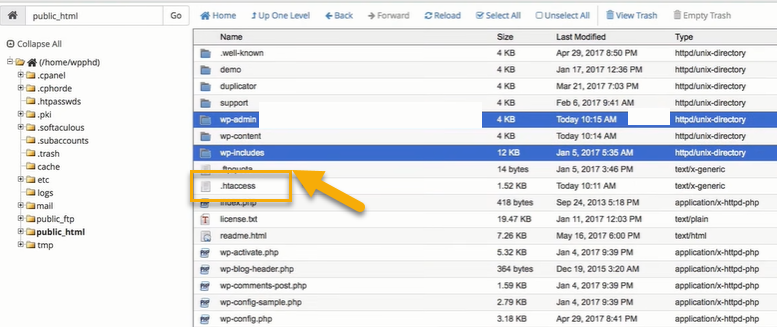
Simply give the .htaccess file a right-click and then select the "View/Edit" option.
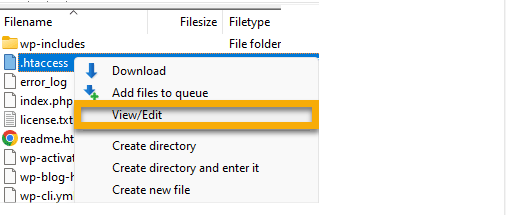
Upon opening this file in an editor, you'll find it blank. To address the issue at hand, simply copy the code provided and paste it into this empty file.

This code enables WordPress pretty permalinks feature by rewriting URLs with the help of the mod_rewrite module in the Apache server. The .htaccess file is a powerful configuration file that can control many aspects of your site's web server behavior.
Secondly sometimes, an error may arise as a result of a certain issue.PHP timeout. If you're working on something that takes a long time to process, such as uploading a large file, try increasing your PHP limit.
Now, Download wp-config.php file from the Cpanl of the hosting login.

Now open this file, it will look like this;
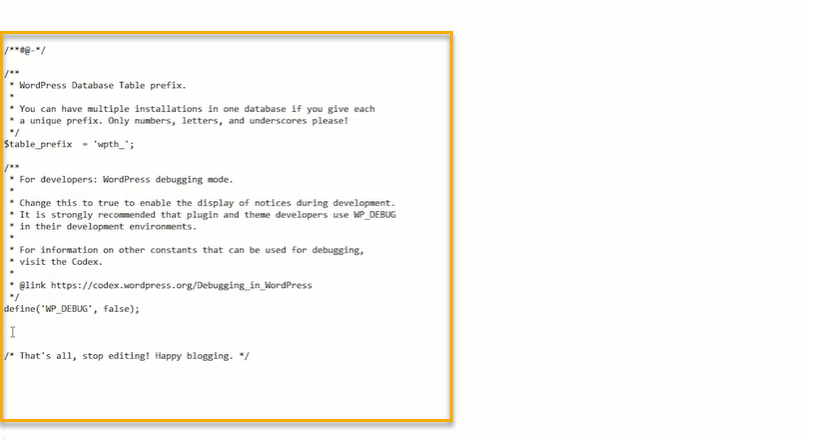
Now at the end you need to add this command define( 'WP_MEMORY_LIMIT', '256M' );
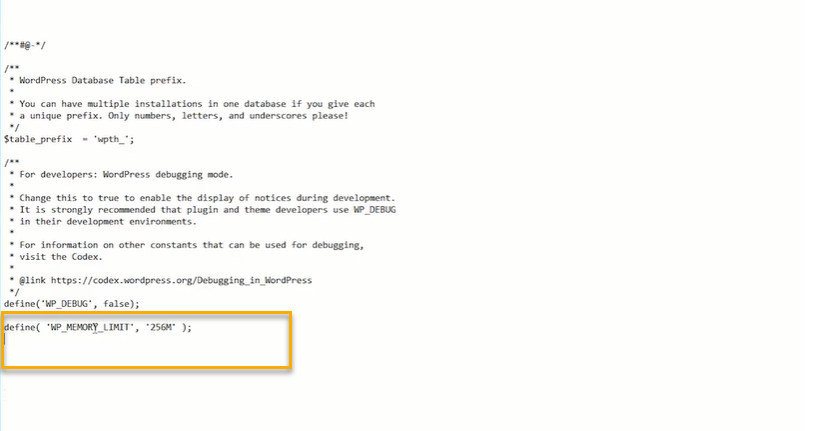
Once you've entered the necessary code into the file, go ahead and upload it back to its original location. You'll be prompted to confirm the upload, to which you should click "yes." You'll notice the file size has changed. After refreshing your site, you should find it operating smoothly once again.
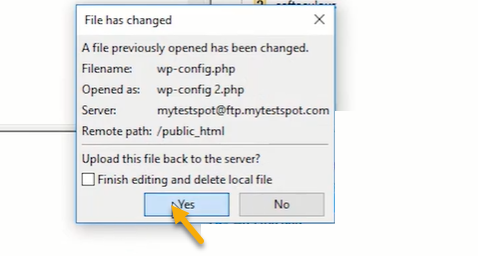
Thirdly, if none of the above works, the error may be caused by a problem on the server side. You should contact your hosting provider to ask them to investigate this. They should be able to identify the cause of the error and guide you on how to resolve it. Remember, 500 Internal Server Errors can be due to various issues, and it often takes a process of elimination to find the culprit.
Error 3: How Can You Fix Error Establishing Database Connection
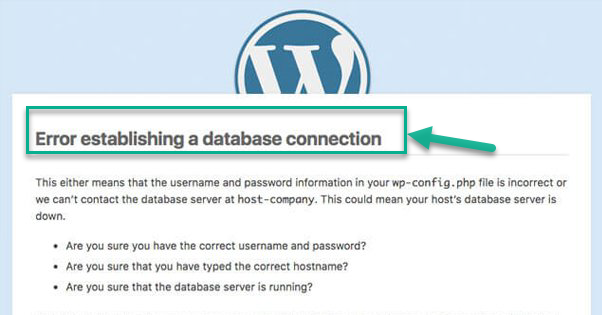
The "Error Establishing a Database Connection" is a common issue in WordPress that occurs when WordPress is unable to connect to the database where all your website content and settings are stored.
WordPress uses a MySQL database to store all your website data, including posts, pages, comments, and other website settings. It needs to connect to the database each time someone visits your site.
If, for some reason, WordPress cannot connect to the database, it displays the "Error Establishing a Database Connection" message.
This error can occur due to several reasons:
- Database Server Down: If the MySQL server is unresponsive, WordPress will be unable to establish a connection. This could happen if the server is overloaded, undergoing maintenance, or experiencing other issues.
- Wrong Database Credentials: WordPress needs the correct database name, username, password, and server information to connect to the database. If any of these are incorrect (often due to changes in your hosting environment), WordPress won't be able to connect.
- Corrupted WordPress Files: If core WordPress files have become corrupted, it could cause a database connection error.
- Database Corruption: Databases can become corrupted due to a server crash, hack, or faulty plugin. This could result in an error.
Solution
1. Need to Check Your WordPress Database Credentials
You'll need to find the following lines in wp-config.php.
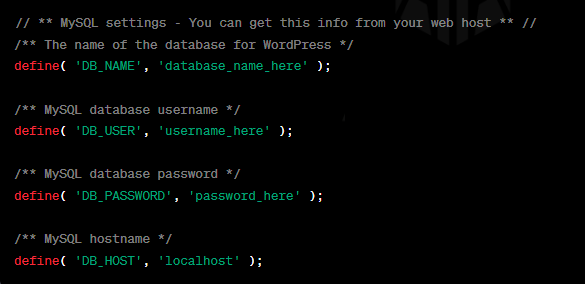
In this step, it's essential to confirm that your database name, username, password, and database host details are all accurate.
You can verify this information through your WordPress hosting account dashboard. In our case, we're referencing the Bluehost dashboard, but rest assured, the process remains similar across most hosting providers.
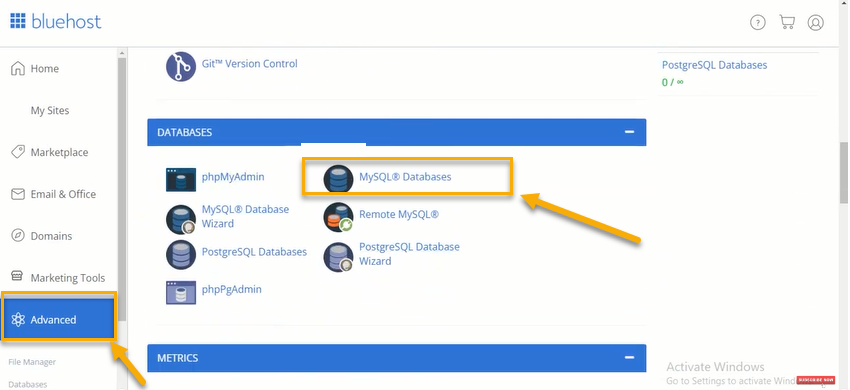
Upon selecting "MySQL Databases," you'll be directed to the database management page. Here, your task is to navigate to your current database.

Upon clicking on the provided link, you'll find options not only to modify your password but also to rename your databases as needed. Once you've made the necessary modifications, the next step is to revisit your website to see if the database connection issue has been resolved.

2. Check Your Database Server Is Down
It's important to remember that despite your best efforts, issues can still arise with your database connection, often due to factors beyond your control, such as heavy server traffic. If you find yourself encountering persistent issues, don't hesitate to reach out to your hosting provider for assistance, particularly with assessing the responsiveness of your MySQL server.
You can also perform checks on your own, such as testing other websites hosted on the same server or attempting to access phpMyAdmin via your hosting dashboard.
Creating a 'testconnection.php' file can be another effective method for verifying if your database user has the appropriate permissions. By following these steps, you should be better equipped to diagnose and resolve any WordPress database connection issues.

In a typical IDE, the keywords (like if, echo, and die), functions (like mysqli_connect and mysqli_close), and strings (the text in quotes) would all be color-coded to make them stand out from each other and easier to read.
Error 4: How Can You Fix Mixed Content Error in WordPress
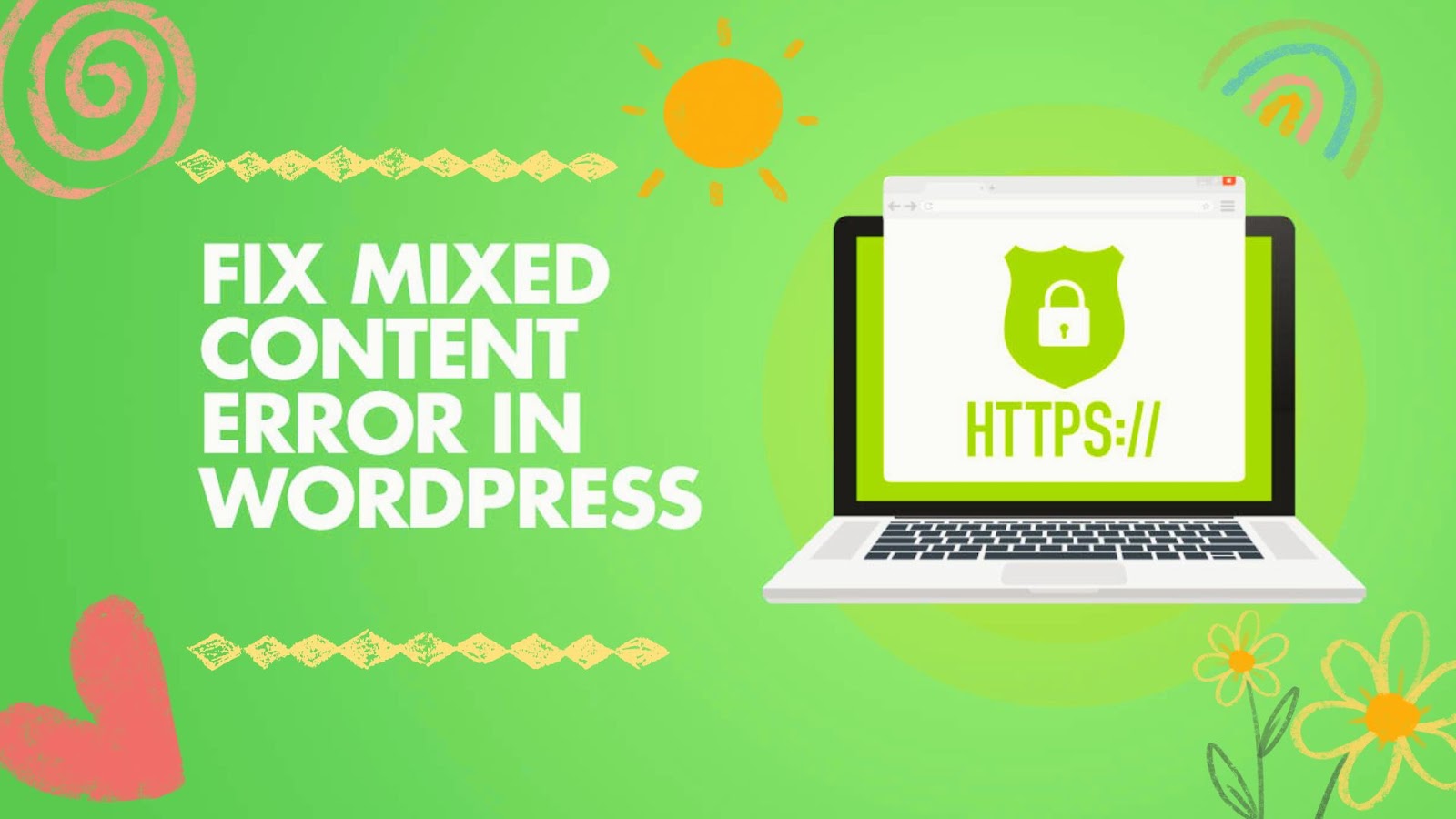
The Mixed Content Error in WordPress occurs when a website is loaded over a secure HTTPS connection, but some resources (like images, videos, stylesheets, and scripts) on the page are loaded over an insecure HTTP connection.
This discrepancy can create a security vulnerability, as the insecure content can be exploited by malicious parties.
In terms of when this error occurs, it typically happens after a site has been moved from HTTP to HTTPS. If not all of the content was successfully updated to the secure protocol, you'd see this error.
It can also occur when adding new content to your site; if you're not careful, it's possible to accidentally include resources that are loaded over HTTP.
Modern browsers often block mixed content by default or at least warn the user about it, as it poses a risk to the secure HTTPS connection.
For website owners, it's important to fix mixed content errors to maintain site security, user trust, and SEO ranking. This usually involves identifying and updating the offending resources to use HTTPS instead of HTTP.
Solution
Let's pivot our focus now to the solution for the Mixed Content Error in WordPress. This common hiccup can cause quite a headache, but we've got your back. You see, we've already crafted an in-depth guide to navigating you through the process of fixing this error.
So, why not take a moment to delve into the guide below? It'll equip you with the knowledge you need to tackle the mixed content error with confidence."
How to Fix Mixed Content Error in WordPress (Ultimate Guide)
Error 5: How Can You Fix PHP Errors

PHP errors occur when there's an issue with the PHP code that's running your website. PHP (Hypertext Preprocessor) is a widely-used open-source scripting language that is especially suited for web development and is embedded within HTML. It's used extensively in WordPress core, as well as themes and plugins.
When your WordPress site experiences a PHP error, it can be due to a variety of reasons:
- Runtime Errors: These are errors that happen while the script is running. These could be things like calling an undefined function, trying to access a file that doesn't exist, or using incorrect data types.
- Logical Errors: These are the most difficult to spot as they don't stop the execution of the script, but they interfere with the intended output. They could be due to using incorrect logic or functions in the code.
- Deprecated Code: These errors occur when your WordPress site, theme, or plugins are using PHP functions or features that have been removed or deprecated in the newer versions of PHP.
- Resource Limitations: If your PHP scripts require more memory or execution time than what is currently allocated by your server settings, errors can occur.
These PHP errors usually display warnings or notices on the screen, or they may cause parts of your website to malfunction, or in severe cases, a "white screen of death" may appear.
They can be resolved by fixing the syntax, removing deprecated code, increasing resource limits, or correcting logical and runtime errors in the PHP code.
It's recommended to turn on 'WP_DEBUG' in your WordPress 'wp-config.php' file to help identify the source of the error. However, fixing these issues typically requires some understanding of PHP and WordPress development.
Solution
To rectify the PHP memory error, you need to first access the cPanel of your hosting server. Once you're there, you will need to locate the wp-config.php file. Once you've found it, just click on it.
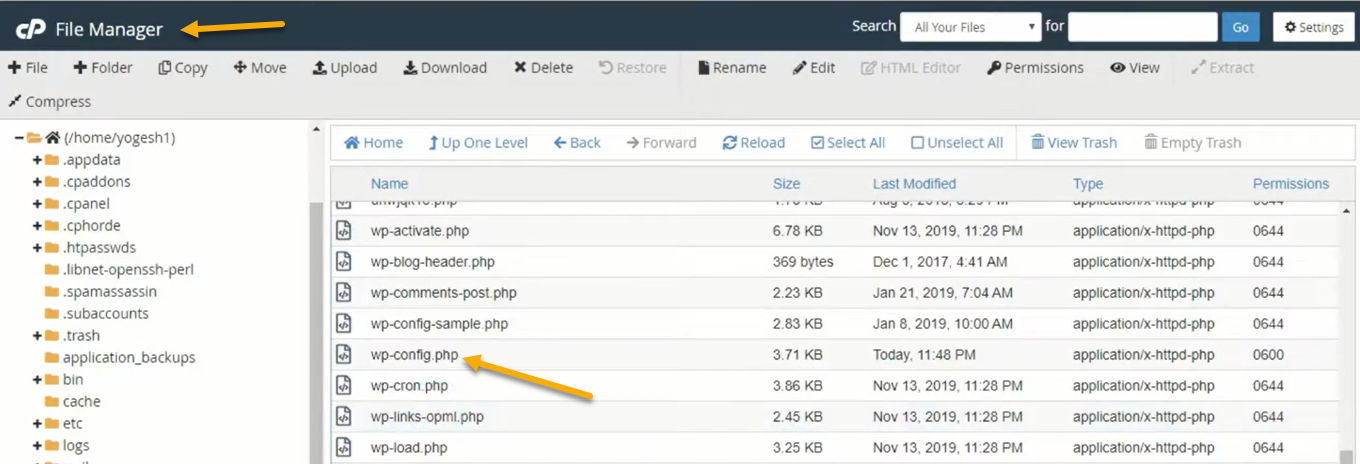
Now, the next step is to modify this file. Once you've opened the file for editing, you're going to add a piece of code at the end of the existing code. After you're ready, go ahead and click on 'Edit.'

The code you'll see should resemble the one provided below. Your task is to look for the command that says define (‘WP-DEBUG’ , true); Once you've located it, you're going to add a new line command to augment the PHP memory.

The specific command you'll be inserting at this point to resolve the PHP memory error is

Now, take this code and paste it into the location that we discussed earlier."

Once you've done that, you should notice that your WordPress login is functioning properly and the PHP memory error has been successfully resolved.
Error 6: How Can You Fix Syntax Error

A WordPress syntax error, also known as a parse error, typically occurs when there is a mistake in the code of your WordPress website. This can happen in the PHP programming language that WordPress is built on.
Here are some situations when it could occur:
- Editing Theme or Plugin Files: If you're manually editing WordPress theme or plugin files and make a mistake - even a small one like a missing semicolon, bracket, or incorrect syntax - it can result in a syntax error.
- Installing a Poorly Coded Plugin/Theme: If you install a plugin or theme that has been poorly coded or not updated to work with the latest version of WordPress, it can throw a syntax error.
- Updating WordPress Core, Plugins, or Themes: Sometimes, a syntax error can occur when updating WordPress core files, plugins, or themes. If the update includes code incompatible with other parts of your site, it can result in a syntax error.
When a syntax error occurs, you'll typically see a message like "Parse error - syntax error, unexpected $end in /public_html/your_site/wp-content/themes/your_theme/functions.php on line 123". This message indicates the file and the line of code where the error occurred.
Solution
"First off, you'll need to incorporate the WP Code plugin into your WordPress site. After installing it, don't forget to click 'Activate' to get it up and running."
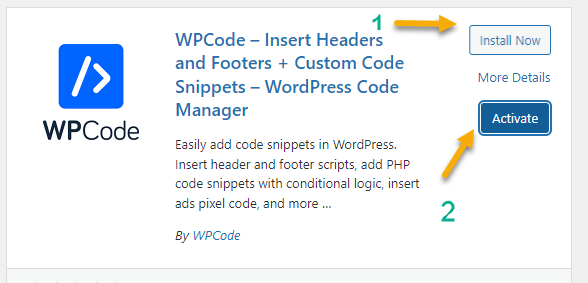
Next up, click on the 'Code Snippets plugin. If you're introducing any custom code, the WP Code plugin is designed to automatically identify any errors, making your error resolution process much more straightforward.

One of the great features of WPCode is that it automatically deactivates your custom code if it spots a syntax error. So, rest easy knowing you won't accidentally cause any site disruptions when adding code snippets."

Error 7: Uploaded File Exceeds the Upload_Max_Filesize Error

The "Uploaded File Exceeds the Upload Max File Size" error in WordPress occurs when you're trying to upload a file that's larger than the allowed limit set in your server's PHP configuration.
Each server has settings that specify the maximum file size that can be uploaded at a time, and this is dictated by two PHP settings: upload_max_filesize and post_max_size.
If the file you're trying to upload in WordPress exceeds either of these values, you'll see the "Uploaded File Exceeds the Upload Max File Size" error.
This error most commonly occurs when you're trying to upload a large theme or plugin file, a media file, or when you're importing a large WordPress database.
To resolve this, you'll typically need to increase the upload_max_filesize and post_max_size limits. This can be done in various ways, such as editing your site's .htaccess file, changing the PHP settings in your hosting control panel, or contacting your hosting provider for assistance.
Solution
Let's dive into tackling the 'Uploaded File Exceeds the Upload_Max_Filesize Error.' We've crafted a visual, step-by-step guide that will lead you smoothly through fixing this error. This is going to greatly impact and benefit you.
So, if you're on a quest for a solution, we highly recommend checking out our detailed guide to fix the Upload_Max_Filesize Error. It's tailor-made to help you solve this issue effectively and effortlessly.
How to Fix the Uploaded File Exceeds the Upload_Max_Filesize Error
Error 8: How Can You Fix Getting Locked Out of the WordPress Dashboard

Getting locked out of the WordPress dashboard means that you're unable to access the admin area of your WordPress site. This can occur due to various reasons:
- Lost Password: The most common reason for getting locked out is forgetting your password. WordPress has a built-in recovery mechanism, but this can sometimes fail, especially if your site's email functions are not working correctly.
- Plugin Errors: Certain plugins, especially security plugins, can lock you out if they detect unusual activity or if they're misconfigured.
- Theme Issues: If your active theme is causing issues, it might prevent you from accessing the dashboard.
- Incorrect Login Details: If your username or password details are incorrect or changed, you will be unable to log in.
- Changes in User Permissions: If your user permissions were accidentally changed or if the account was deleted, you could be locked out.
- Failed Auto-Update: WordPress has an auto-update feature. If an update fails, it can leave your site in maintenance mode, locking you out of the dashboard.
- Website Hacked: In the worst-case scenario, if your site has been hacked, the hacker might change your login details, locking you out.
Solution

Next up, let's address this error. What you'll need to do is head over to your hosting dashboard. From there, you'll find your way into its Cpanel. Look out for the "Advanced" option on your dashboard; it should be pretty noticeable.
Once you click on it, a pop-up will appear. In this pop-up, there will be a "PhpMyAdmin" option; you'll want to click on that. And that should help in resolving your issue.

Alright, here's what you need to do next. You'll have to update a couple of files in WordPress. They're called "wp-user meta" and "wp-users." To access these, you can go through phpMyAdmin in the WordPress database.

"Next, what you're going to want to do is look towards the top of your screen. There, you'll find the 'Insert' button. Go ahead and give that a click."

"It's necessary for you to complete the insert form in the same manner as displayed in our screenshot below."

Alright, next, let's talk about how to add a user to the wp_usermeta Table. It's a fairly straightforward process. You'll want to leave the 'umeta_id' field empty because it's automatically generated.
Now, in the user ID field, input the same information as you did in the previous form. For the meta_key field, you need to fill in 'wp_capabilities.' And finally, in the meta_value field, you're going to insert this: 'a:1:{s:13:"administrator";s:1:"1";}'.

Now, as you scroll down a bit, you'll find that there's a requirement to fill in 'wp_user_level' in the meta-key field and '10' in the meta-value field. It's important to note that the User ID should be consistent with the previous one and that the “umeta_id” field should be left empty.

"Finding the new user is a breeze. Just head over to your WordPress Dashboard and look for the 'Users' option. Once you click on that, a pop-up will appear. All you need to do is click on 'All Users' within that pop-up."

Error 9: How Can You Fix HTTP Error While Uploading Images
An HTTP error while uploading images in WordPress is an issue that typically occurs when you are trying to upload images using the built-in media library tool in WordPress. This error prevents the image from being uploaded to the site.
Here are some common reasons when this error might occur:
- Incorrect File Permissions: Your WordPress files and folders have specific permissions that determine who can read, write, and execute the files. If these permissions are incorrect, WordPress may have trouble uploading images.
- Lack of Memory: Sometimes, your WordPress hosting provider might have set a low PHP memory limit, which can exhaust your memory and result in this error.
- Plugin Conflict: Certain plugins, especially image optimization or security plugins, might cause conflicts that prevent images from being uploaded.
- Imagick Library Limitations: WordPress uses two modules to process images – GD Library and Imagick. Imagick is known to have memory issues causing the HTTP error.
- File Size Too Large: If the image file size is too large, your WordPress setup or hosting environment might not allow it to be uploaded.
- Temporary Issues: Occasionally, a temporary glitch or an issue with the browser can trigger the HTTP error.
Solution
Here are some ways to fix this error
- Refresh your browser
- Rename the File
- Resize the File
- Temporarily Deactivate Your Plugins
1. Refresh Your Browser
Every time I reach out to Apple support, their first piece of advice always seems to be: 'Did you try restarting your computer?' It might sound a bit irritating to hear, but truth be told, it's solid advice. It's important to rule out if the problem you're facing is just a temporary hiccup.
In the same vein, the initial step in diagnosing the HTTP image upload error should be to give your browser a quick refresh and try uploading the file once more. Occasionally, a fleeting issue with your Wifi or hosting provider might stand in the way of a successful file upload.
2. Rename the File
"If refreshing your browser isn't doing the trick, a simple next step could be to rename the file you're attempting to upload. The HTTP error message might be popping up due to special characters in the file name, such as apostrophes, semi-colons, or international language symbols.
So, give your file a new name and try uploading it once more. If this method doesn't solve the issue, don't worry, we have another approach you can try to overcome this image HTTP error."
3. Resize the File
If the HTTP image upload error message keeps popping up, the issue might just be that your image file is a tad too large. To keep it below the maximum upload file size, you could consider resizing and compressing your image.
There are numerous image optimization plugins that can assist you with this, or you could opt for free tools such as Squoosh.
4. Temporarily Deactivate Your Plugins
There's a possibility that the HTTP image upload error you're experiencing on your WordPress site could be due to some specific plugins. Particularly, plugins related to image optimization and security have often been found to trigger this sort of nondescript message.
If you've recently activated a plugin and are now encountering an image upload error, there's a quick fix you can try. You'll need to temporarily deactivate the plugin. Just head back to your dashboard and click on the plugin in question to do so.

Once you've selected the Plugin, you'll be able to see all your installed plugins. From there, all you need to do is click on 'deactivate.'

If disabling plugins fixes the error, then you'll likely need an alternative solution for your website. It would be a good idea to get in touch with a developer in this situation.
Error 10: How Can You Fix Secure Connection Error in WordPress
A Secure Connection Error in WordPress usually arises when your WordPress site or the server on which it resides cannot make a secure connection to WordPress.org.
This is an issue that most commonly happens when you are trying to install or update plugins, themes, or WordPress core files directly from your dashboard.
Here are some possible reasons for this issue:
- Blocked Requests: Your WordPress hosting server might be blocking outgoing requests. This could be a security measure taken by your hosting provider to prevent unauthorized changes to your site.
- Firewall Configuration: If your WordPress server has a firewall installed, it might be blocking the outgoing connection. This is commonly found in dedicated servers or Virtual Private Servers (VPS).
- DNS Server Issues: Your DNS server might be unable to resolve the domain name, which can prevent connections to WordPress.org.
- Misconfiguration of SSL/TLS on your Server: If SSL/TLS, the protocols that provide the "Secure" in Secure Socket Layer, isn't correctly configured on your server, this can interfere with secure connections.
- Outdated WordPress Software: Older versions of WordPress may have issues making secure connections due to deprecated code or outdated server software requirements.
Solution
Are you encountering security issues with your WordPress site? If so, there's no need to panic. We understand how crucial security is for your online presence, and we're here to help. We've curated a comprehensive guide that specifically addresses these security-related concerns.
To access our solutions and ensure your site remains secure, simply visit the guide below. Let's work together to keep your WordPress site safe and secure.
How to Fix a Hacked WordPress Website [5 Easy Steps]
Error 11: How Can You Fix WordPress RSS Feed Issues
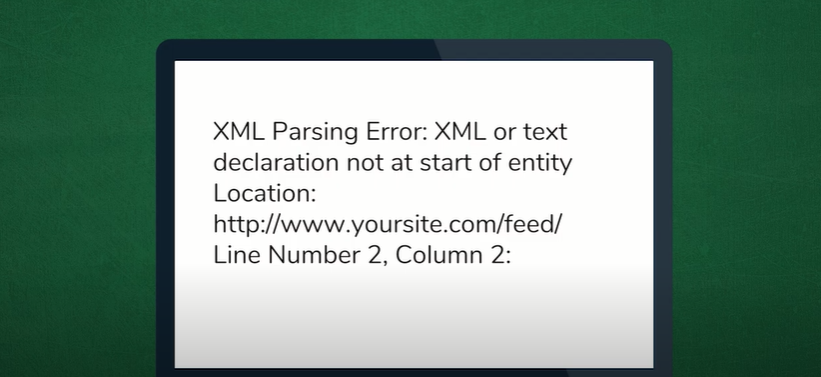
RSS (Really Simple Syndication) Feed issues in WordPress typically arise when the RSS feed is not working or is not formatted properly.
This could mean that users subscribing to your RSS feed are unable to receive updates or that certain applications or services that rely on your RSS feed are not functioning correctly.
RSS feed issues can occur due to various reasons:
- Poorly Formatted XML: RSS feeds are generated in XML, a markup language that has very strict syntax rules. Even a minor mistake, such as a missing closing tag or a misplaced character, can cause the RSS feed to break.
- Blank Lines or Spaces: If there are blank lines or spaces at the beginning or the end of your functions file (functions.php), it could result in RSS feed errors.
- Faulty Plugins or Themes: Certain plugins or themes may interfere with the RSS feed generation process, leading to issues.
- Special Characters: If a post or page content contains some special characters, these can sometimes interfere with the formatting of the RSS feed.
When these issues occur, users trying to access your feed will generally see an error message.
The solution could involve fixing the formatting error, removing the blank spaces, disabling faulty plugins or themes, or dealing with special characters.
Solution
In case you encounter an RSS Feed Error on WordPress, you're likely to come across a message that looks similar to this.

You might see a bit of variation in this error based on the browser you're using. For instance, if you're accessing the feed through your browser, you might encounter an error message that looks something like this:

Alright, resolving this error is pretty straightforward. Just turn on the "Fix my Feed RSS Repair" plugin. You can do this from your dashboard. Just head over to the 'plugins' section and select 'add new'.

You'll need to navigate over to the search tab. Once there, try to look up 'Fix my Feed RSS Repair.' When you've found it, go ahead and click 'install.' After it's been installed, don't forget to activate it."

Once you've successfully installed this plugin, please navigate back to the dashboard. From there, select 'Tools.' A pop-up will appear where you'll find 'RSS Feed Fix.' Just click on it, and you'll be all set.

When you select the 'RSS Feed Fix,' what you'll see is a new window popping up, much like the one shown here.
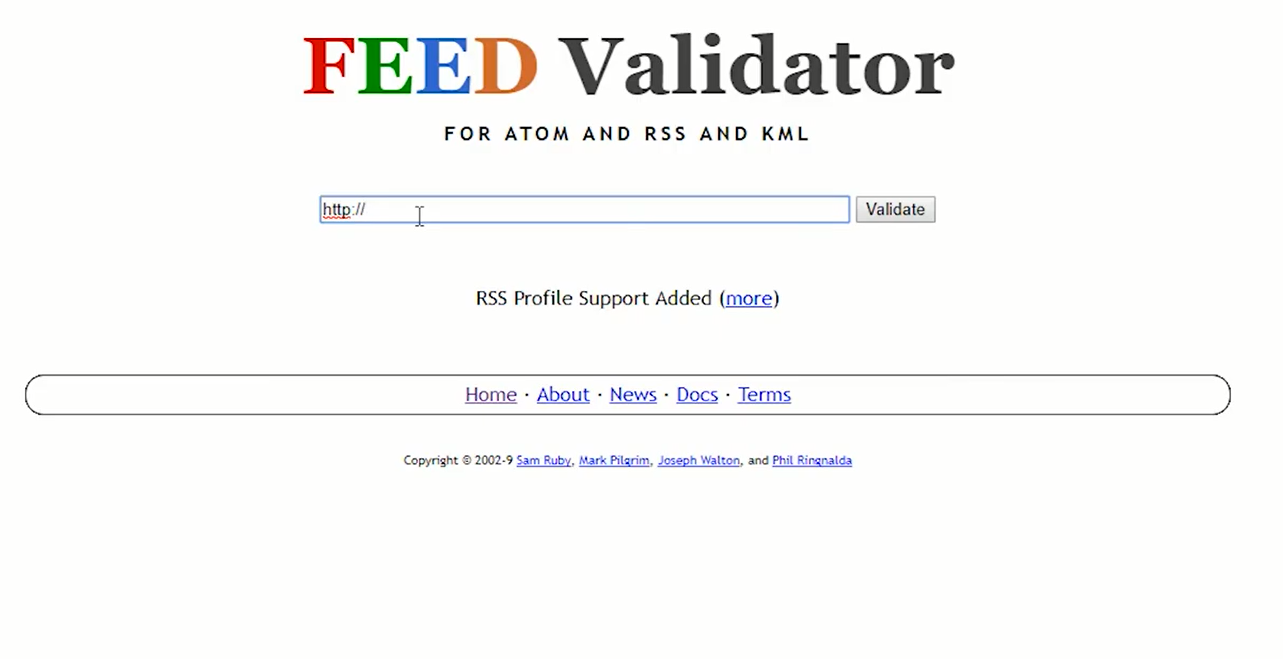
In the 'validate' bar, you'll want to enter your website's URL. Once you've done that, go ahead and hit the 'validate' button."

Once you've hit the validate button, you'll notice that your issue has been resolved.

Error 12: How Can You Fix 404 File Not Found

The "404 File Not Found" error is a standard HTTP response status code. It is the message that your browser displays when it requests a web page from a server and that server can't find the requested page. Here's when it can occur:
- Page Removed or Moved: If a web page has been deleted or its URL has been changed without implementing a redirect, a visitor trying to access the old URL will see a 404 error.
- Broken or Incorrect Links: This error can also happen when a link points to a page that doesn't exist. This could be because of a typo in the URL or a mistake when creating the link.
- Website Restructuring: If a website has gone through significant changes, old pages might be deleted or moved. Unless redirects are properly set up, this will lead to 404 errors when accessing those old pages.
- Server Issues: Sometimes, the problem is not with the webpage, but with the server it's hosted on. If the server is down or there's an issue with the server's configuration, it might not be able to serve the requested page, leading to a 404 error.
Solution
Should you encounter pervasive 404 errors throughout your site when attempting to view material, the most probable culprit tends to be your permalinks or, in the event of your host employing Apache, your .htaccess file.
For those who are customers of Kinsta, since we employ Nginx, the .htaccess file can be safely dismissed as a potential issue.
Rectifying this problem is straightforward and can be done via the WordPress administrative panel. All it requires is a trip to Settings → “Permalinks”, followed by hitting the “Save Changes button”. Note that you aren't required to make alterations – simply clicking Save Changes will suffice.

When you select the permalinks, you'll notice a new window appearing like this;

Error 13: How Can You Fix WordPress Permalink Not Working
The WordPress Permalink Not Working error usually manifests as a 404 error, indicating that the requested URL was not found on the server. Essentially, this error occurs when your website cannot match the requested URL to an existing page or post.
You may come across this issue in various situations.
- Changing the Permalink Structure: If you recently changed the permalink structure of your site, links with the old structure might not work anymore.
- Moving or Deleting Pages: If you moved or deleted a page without setting up a redirect, anyone trying to access the original URL will see a 404 error.
- Issues with .htaccess file: The .htaccess file is a configuration file used by WordPress to manage URL structures. If there are issues with this file (such as incorrect rules or file corruption), your permalinks may not work properly.
- Conflicts with a Plugin or Theme: Sometimes, a plugin or theme might interfere with WordPress's URL rewriting capabilities, leading to permalink errors.
- Server Configuration: If your server is not properly configured to handle the permalink structure, it may result in errors.
Solution
Finally, we're onto the solution you've been waiting for - how to fix the 'WordPress Permalinks Not Working issue. Now, we're not going to sugarcoat it - it's an easy process, but it might take a bit of your time.
To make it as straightforward as possible for you, we've created a dedicated, step-by-step guide. This way, you can focus solely on tackling this problem without any unnecessary distractions. Simply click the link below, and you'll be one step closer to resolving your permalink issues.
How to fix WordPress Permalinks Not Working
Wrapping Up
To encapsulate, the functioning of a WordPress site can be encumbered by an assortment of common errors, each with unique causes and solutions.
Issues such as the White Screen of Death (WSOD), 500 Internal Server Error, and Error Establishing Database Connection arise from PHP, database, or .htaccess file issues, server configurations, and incorrect database credentials.
These can often be addressed by cache clearing, enabling WordPress to debug mode, and verifying database credentials.
Further errors, such as Mixed Content Errors, PHP errors, and Syntax errors, have their roots in the transition from HTTP to HTTPS, PHP code issues, and coding mistakes.
Solutions involve updating resources to use HTTPS, rectifying PHP syntax, increasing resource limits, and employing the WP Code plugin for syntax errors.
More WordPress errors include the "Uploaded File Exceeds the Upload Max File Size," being locked out of the WordPress dashboard, HTTP error while uploading images, and secure connection error.
These can be resolved by increasing PHP configuration limits, updating WordPress files through PhpMyAdmin, renaming or resizing files, and ensuring up-to-date WordPress software.
Lastly, RSS Feed Issues, "404 File Not Found," and Permalink Not Working errors could result from poorly formatted XML, broken links, changes in permalink structure, and .htaccess file issues.
Remedies can involve formatting correction, navigating to Permalinks settings, and resolving plugin or theme conflicts.
Although these errors may seem overwhelming, they are usually rectifiable with the correct approach.
However, in complex situations, professional help from your hosting provider can be invaluable. By comprehending these errors and their respective solutions, a smoothly functioning, user-friendly WordPress site can be maintained.
















.svg)
.svg)
.svg)

